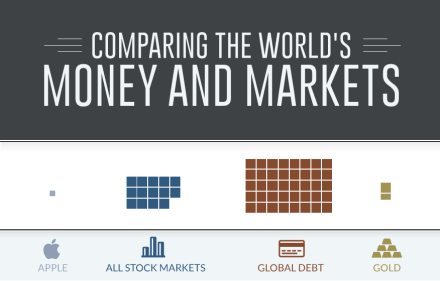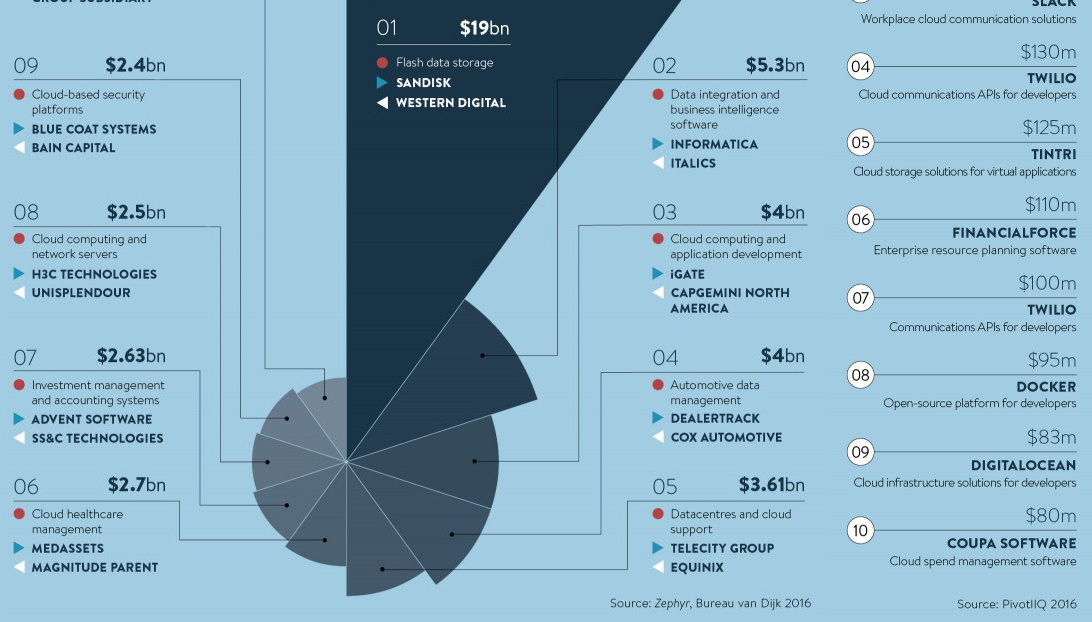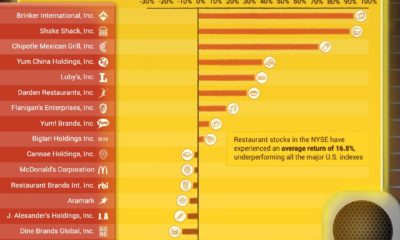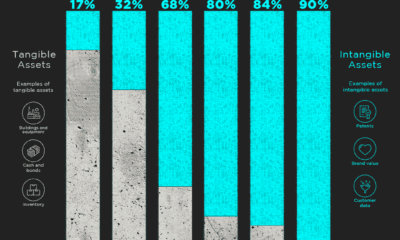Money continued to flow to the cloud storage sector, where a total of 1,800 transactions were made in 2015 for a total value of more than $100 billion. The largest of these deals was between two storage giants, with SanDisk getting gobbled up by competitor Western Digital for a $19 billion price tag. Cloud storage, which allows users and businesses to store vast amounts of data remotely, has been in heavy demand lately. With approximately 2.5 quintillion bytes of data created every day and more people seeking to stream movies, video games, and music from the cloud on a regular basis, there is no other option but to grow the industry at a breakneck pace.
Cloud Nine
Why is the cloud another level above many other tech sub-sectors competing for investment? The answer is simple. It’s no surprise that quality startups focused on the cloud have had no problems raising money. Enterprise SaaS startup Slack, which raised $160 million in 2015 and another $200 million in 2016, was selected as the “Company of the Year” according to Inc. Magazine. It has been one of the fastest growing startups ever, reaching a $1 billion valuation even before its product turned eight months old. GitHub, a repository for software code, had the biggest raise for cloud-focused startups last year. The seven year-old company raked in $250 million at a $2 billion valuation to expand internationally and to invest in new products.
A Cloudy Horizon?
Despite a projection of $54.9 billion in annual spend going to cloud infrastructure by 2019, one major concern still remains about the future of cloud computing. The cloud has vast amounts of sensitive data stored in a single place, making cloud providers a particularly attractive target for hackers. With the average cybercrime in the United States costing a company $15.4 million, organizations are actively seeking to shield their digital assets from the millions of cyber attacks launched each year. Cybersecurity is becoming a mission critical feature in both enterprise and government budgets moving forward. If enterprise customers lose faith in the cloud’s ability to keep data secure, there will be a ripple effect on investment and industry growth. For further reading and to get an idea of what these companies are facing, here’s a recent list of the “Treacherous 12” security threats that organizations face when using cloud services.
on But fast forward to the end of last week, and SVB was shuttered by regulators after a panic-induced bank run. So, how exactly did this happen? We dig in below.
Road to a Bank Run
SVB and its customers generally thrived during the low interest rate era, but as rates rose, SVB found itself more exposed to risk than a typical bank. Even so, at the end of 2022, the bank’s balance sheet showed no cause for alarm.
As well, the bank was viewed positively in a number of places. Most Wall Street analyst ratings were overwhelmingly positive on the bank’s stock, and Forbes had just added the bank to its Financial All-Stars list. Outward signs of trouble emerged on Wednesday, March 8th, when SVB surprised investors with news that the bank needed to raise more than $2 billion to shore up its balance sheet. The reaction from prominent venture capitalists was not positive, with Coatue Management, Union Square Ventures, and Peter Thiel’s Founders Fund moving to limit exposure to the 40-year-old bank. The influence of these firms is believed to have added fuel to the fire, and a bank run ensued. Also influencing decision making was the fact that SVB had the highest percentage of uninsured domestic deposits of all big banks. These totaled nearly $152 billion, or about 97% of all deposits. By the end of the day, customers had tried to withdraw $42 billion in deposits.
What Triggered the SVB Collapse?
While the collapse of SVB took place over the course of 44 hours, its roots trace back to the early pandemic years. In 2021, U.S. venture capital-backed companies raised a record $330 billion—double the amount seen in 2020. At the time, interest rates were at rock-bottom levels to help buoy the economy. Matt Levine sums up the situation well: “When interest rates are low everywhere, a dollar in 20 years is about as good as a dollar today, so a startup whose business model is “we will lose money for a decade building artificial intelligence, and then rake in lots of money in the far future” sounds pretty good. When interest rates are higher, a dollar today is better than a dollar tomorrow, so investors want cash flows. When interest rates were low for a long time, and suddenly become high, all the money that was rushing to your customers is suddenly cut off.” Source: Pitchbook Why is this important? During this time, SVB received billions of dollars from these venture-backed clients. In one year alone, their deposits increased 100%. They took these funds and invested them in longer-term bonds. As a result, this created a dangerous trap as the company expected rates would remain low. During this time, SVB invested in bonds at the top of the market. As interest rates rose higher and bond prices declined, SVB started taking major losses on their long-term bond holdings.
Losses Fueling a Liquidity Crunch
When SVB reported its fourth quarter results in early 2023, Moody’s Investor Service, a credit rating agency took notice. In early March, it said that SVB was at high risk for a downgrade due to its significant unrealized losses. In response, SVB looked to sell $2 billion of its investments at a loss to help boost liquidity for its struggling balance sheet. Soon, more hedge funds and venture investors realized SVB could be on thin ice. Depositors withdrew funds in droves, spurring a liquidity squeeze and prompting California regulators and the FDIC to step in and shut down the bank.
What Happens Now?
While much of SVB’s activity was focused on the tech sector, the bank’s shocking collapse has rattled a financial sector that is already on edge.
The four biggest U.S. banks lost a combined $52 billion the day before the SVB collapse. On Friday, other banking stocks saw double-digit drops, including Signature Bank (-23%), First Republic (-15%), and Silvergate Capital (-11%).
Source: Morningstar Direct. *Represents March 9 data, trading halted on March 10.
When the dust settles, it’s hard to predict the ripple effects that will emerge from this dramatic event. For investors, the Secretary of the Treasury Janet Yellen announced confidence in the banking system remaining resilient, noting that regulators have the proper tools in response to the issue.
But others have seen trouble brewing as far back as 2020 (or earlier) when commercial banking assets were skyrocketing and banks were buying bonds when rates were low.

















